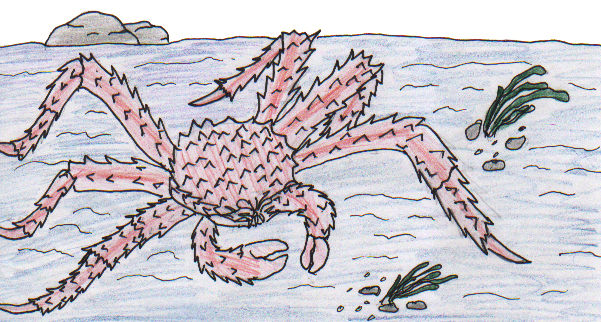 This collection of student work is from Frank Keim's classes. He wants to share these works for others to use as an example of culturally-based curriculum and documentation. These documents have been OCR-scanned and are available for educational use only.
This collection of student work is from Frank Keim's classes. He wants to share these works for others to use as an example of culturally-based curriculum and documentation. These documents have been OCR-scanned and are available for educational use only.Special | A | B | C | D | E | F | G | H | I | J | K | L | M | N | O
P | Q | R | S | T | U | V | W | X | Y | Z | ALL
The King Crab:The King Crab
Paralithodes camtschatica Yuale'rsaq
King crabs live the northern Pacific Ocean and Bering Sea near the United States, Japan and the Russia. They are also an important fishery in these areas. King crabs aren't true crabs. Fleshy abdomens of king crabs are compressed under their bodies and are covered by a series of protective plates. The abdomen of the female crab is fan-shaped and functions as a brood chamber for fertilized eggs. The legs of a King crab are jointed to fold behind the body instead of being jointed forward like the legs of true crabs. The legs and carapace are spiny and provide protection from fish that prey on them. They may grow as large as twenty-four pounds in fifteen years. The commercially caught males are only about seven pounds and are eight or nine years old. They are usually three feet long with their legs extended. King crabs display an annual migration pattern. In late winter they move from the outer continental shelf to water depths of less than 40 fathoms where females molt and are mated. These mating grounds may be along the shore or on submerged offshore banks. Crabs move to deeper water following mating and feed throughout the summer, fall and early winter months. Major fisheries for these crabs are centered at lower Cook Inlet, Kodiak Island, Unimak Pass area, Adak and Atka islands and the eastern Bering sea north of the Alaska Peninsula. Minor fisheries are in Southeastern Alaska and the Shumagin Islands. The crabs are caught with baited pots which are six or seven feet square, three feet high and weigh 500- 700 pounds each. The pots are baited with chopped herring which is usually replaced every two or three days. The King crab fishery started in the early 1950's. The most king crab ever caught was in 1966 when the fisheries caught 159 million pounds.
Charlotte Alstrom
| |
|




